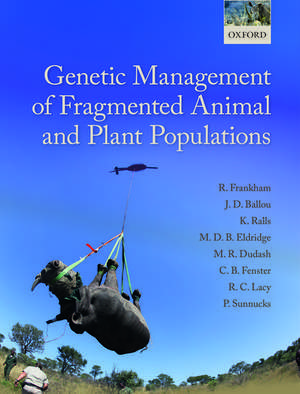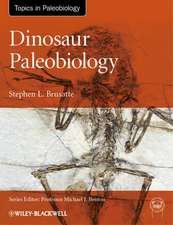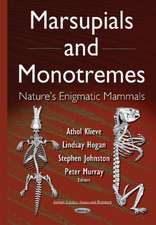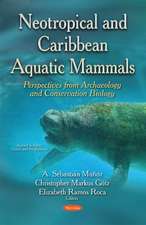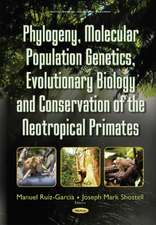Genetic Management of Fragmented Animal and Plant Populations
Autor Richard Frankham, Jonathan D. Ballou, Katherine Ralls, Mark Eldridge, Michele R. Dudash, Charles B. Fenster, Robert C. Lacy, Paul Sunnucksen Limba Engleză Hardback – 13 iul 2017
| Toate formatele și edițiile | Preț | Express |
|---|---|---|
| Paperback (1) | 402.65 lei 31-38 zile | |
| OUP OXFORD – 13 iul 2017 | 402.65 lei 31-38 zile | |
| Hardback (1) | 725.66 lei 31-38 zile | |
| OUP OXFORD – 13 iul 2017 | 725.66 lei 31-38 zile |
Preț: 725.66 lei
Preț vechi: 1023.63 lei
-29% Nou
Puncte Express: 1088
Preț estimativ în valută:
138.85€ • 144.97$ • 114.92£
138.85€ • 144.97$ • 114.92£
Carte tipărită la comandă
Livrare economică 24-31 martie
Preluare comenzi: 021 569.72.76
Specificații
ISBN-13: 9780198783398
ISBN-10: 0198783396
Pagini: 432
Ilustrații: 168 black and white
Dimensiuni: 196 x 248 x 27 mm
Greutate: 1.1 kg
Editura: OUP OXFORD
Colecția OUP Oxford
Locul publicării:Oxford, United Kingdom
ISBN-10: 0198783396
Pagini: 432
Ilustrații: 168 black and white
Dimensiuni: 196 x 248 x 27 mm
Greutate: 1.1 kg
Editura: OUP OXFORD
Colecția OUP Oxford
Locul publicării:Oxford, United Kingdom
Recenzii
This is a book with a mission...the authors do a laudable job of translating conservation genetic concepts into concrete management recommendations, a translation that is often missing in wildlife management.
[This book is] very readable, often unexpected for an academic text. If you struggle with some of the more complex equations there are many practical, interesting and easily understood examples of what they mean, how they have been implemented and the outcomes.
The book is well written, with a wealth of relevant plant and animal examples in a clear, accessible format. Particularly useful is the explanation of the various population genetics statistic approaches, as is the extensive glossary... Highly recommend this book for both academic and practising conservation managers.
The book complements existing conservation genetic textbooks by delving into the specific conservation problem of loss of genetic diversity in small, isolated populations. Its foundation is a paradigm shift in conservation biology, where genetic rescue is more frequently used for the conservation of endangered populations, and it provides managers with the decision tools to effectively implement genetic rescue.
This is likely to become a standard text on the subject; it should be essential for any library serving a conservation biology program. Essential.
It provides a thorough exploration of the genetic issues faced by fragmented populations, the reasons why the use of genetic rescue has been limited to date and the theory and practicalities of re-establishing gene flow.
[This book is] very readable, often unexpected for an academic text. If you struggle with some of the more complex equations there are many practical, interesting and easily understood examples of what they mean, how they have been implemented and the outcomes.
The book is well written, with a wealth of relevant plant and animal examples in a clear, accessible format. Particularly useful is the explanation of the various population genetics statistic approaches, as is the extensive glossary... Highly recommend this book for both academic and practising conservation managers.
The book complements existing conservation genetic textbooks by delving into the specific conservation problem of loss of genetic diversity in small, isolated populations. Its foundation is a paradigm shift in conservation biology, where genetic rescue is more frequently used for the conservation of endangered populations, and it provides managers with the decision tools to effectively implement genetic rescue.
This is likely to become a standard text on the subject; it should be essential for any library serving a conservation biology program. Essential.
It provides a thorough exploration of the genetic issues faced by fragmented populations, the reasons why the use of genetic rescue has been limited to date and the theory and practicalities of re-establishing gene flow.
Notă biografică
Emeritus Professor Richard Frankham is one of the leading international figures in conservation genetics, having been a pioneering researcher in the discipline and senior author on the first textbooks in the field. In 2005 he was awarded a DSc by Macquarie University (Sydney, Australia), based upon his published work (now > 160 publications). Throughout his career he has worked on the genetic impacts of small population sizes in the contexts of conservation and evolutionary genetics and animal breeding. His background is in agriculture (BScAgr [Hons 1] and PhD from the University of Sydney, Australia). He worked for Agriculture Canada (1967-69), followed by a postdoctoral fellowship at the University of Chicago (1969-71), before spending 31 years at Macquarie University. He officially retired in 2002, but continues to work full-time. In 2004, he was Hrdy Visiting Professor in conservation biology at Harvard University, USA.Jonathan Ballou is a Research Scientist Emeritus at the Smithsonian Institution's Smithsonian Conservation Biology Institute in Washington, DC and from 2003-2006 was Head of its Department of Conservation Biology. His research has focused on the genetic and demographic problems confronted by small populations, especially of threatenedspecies. He is recognized as a leader in developing the theoretical basis for the genetic management of small populations and in developing population management tools (software, applied theory) that are widelyand internationally used by wildlife and zoo managers. Jon received his bachelor's degree in Animal Behavior from the University of Virginia in 1977, his masters in statistics at George Washington University in 1985 and his PhD in Population Genetics from the University of Maryland in 1995.Katherine Ralls is interested in the behavioral ecology and conservation genetics of mammals. She studied biology at Stanford and received her PhD from Harvard. An Emeritus Research Zoologist with the Smithsonian's Conservation Biology Institute, she worked at the Smithsonian's National Zoo from 1976 until her retirement in 2014. Her work with co-author Jonathon Ballou on inbreeding problems in captive mammals led to her interest in conservation. In addition to her work on the genetics of small populations, she helped found the Society for Conservation Biology, studies endangered foxes and sea otters, and has served on recovery teams for several endangered species.Mark Eldridge studied genetics and zoology for a BSc (Hons) at Macquarie University and then received a PhD from Macquarie University in 1992. He was awarded an Australian Postdoctoral Research fellowship in 1992 and a QEII Fellowship in 1999. He was appointed as a Research Scientist at the Australian Museum in 2007 and has continued to use molecular techniques to study marsupial evolution, taxonomy and conservation biology.Michele Dudash is a population biologist by training, thus her research focuses on both the ecological and genetic factors responsible for a population's persistence or demise in nature. In this context the major theme of her research has been on the ecology and evolution of reproductive systems in nature. Topics she has investigated with colleagues and students include plant mating system evolution, plant-pollinator interactions, demography of populations, and the role inbreeding, inbreeding depression, and phenotypic plasticity play in the evolution of plant populations. Her research program also directly applies to the need for baseline data that may be utilized to help form successful conservation and restoration management plans for threatened taxa. In addition to her prior academic appointments Michele has served at the National Science Foundation and is currently in an administrative Head post.Born in Queens, NYC, Charles Fenster developed an early interest in population dynamics and genetics that was piqued by observations in Flushing Meadows, and fostered by mentors and peers at Stuyvesant High School and the Jackson Laboratory (notably Robert Collins). While at Amherst College he was inspired to redirect his interests in genetics to evolution by Douglas Schemske who later became his PhD mentor at the University of Chicago. Douglas Schemske and later postdoc mentors at the University of Toronto, Spencer Barrett and Kermit Ritland, encouraged genetic studies in a natural context as an effective way to understand the genetics underlying evolutionary process. These research goals also naturally led to an interest in the conservation of biodiversity, which this book represents. His current work focuses on the origin of genetic diversity through the study of mutations, as well as investigations on the relationship between angiosperm structure and function as a model for natural selection.Robert C. Lacy is a Senior Conservation Scientist for the Chicago Zoological Society, and is on the faculty of the Committee on Evolutionary Biology at University of Chicago. He has served as Chair of the IUCN Conservation Breeding Specialist Group (2003-2011), and was Chair of an IUCN Species Conservation Planning Task Force that developed a framework for strategic planning for species conservation. Together with Jonathan Ballou, he helped to develop the pedigree analysis methods used for the management of captive populations in zoos. Similarly, his population viability analysis software (Vortex) is used by conservationists, wildlife managers, researchers, and students throughout the world to help guide species risk assessments and conservation planning. Paul Sunnucks studied Zoology at Oxford University, and then completed a PhD in population biology at University College London. During three years in one the world's first conservation genetics groups at the Institute of Zoology London, Paul married Australian Andrea Taylor and subsequently migrated to Australia. Following research positions in Sydney, and embarking on parenting, he moved to Melbourne. Since 2005 at Monash University, he has headed the Persistence and Adaptation Research Team. Paul's research applies ecological genomics to conservation-relevant population biology. He has a particular liking for all lifeforms, and working with smart, fun people.
